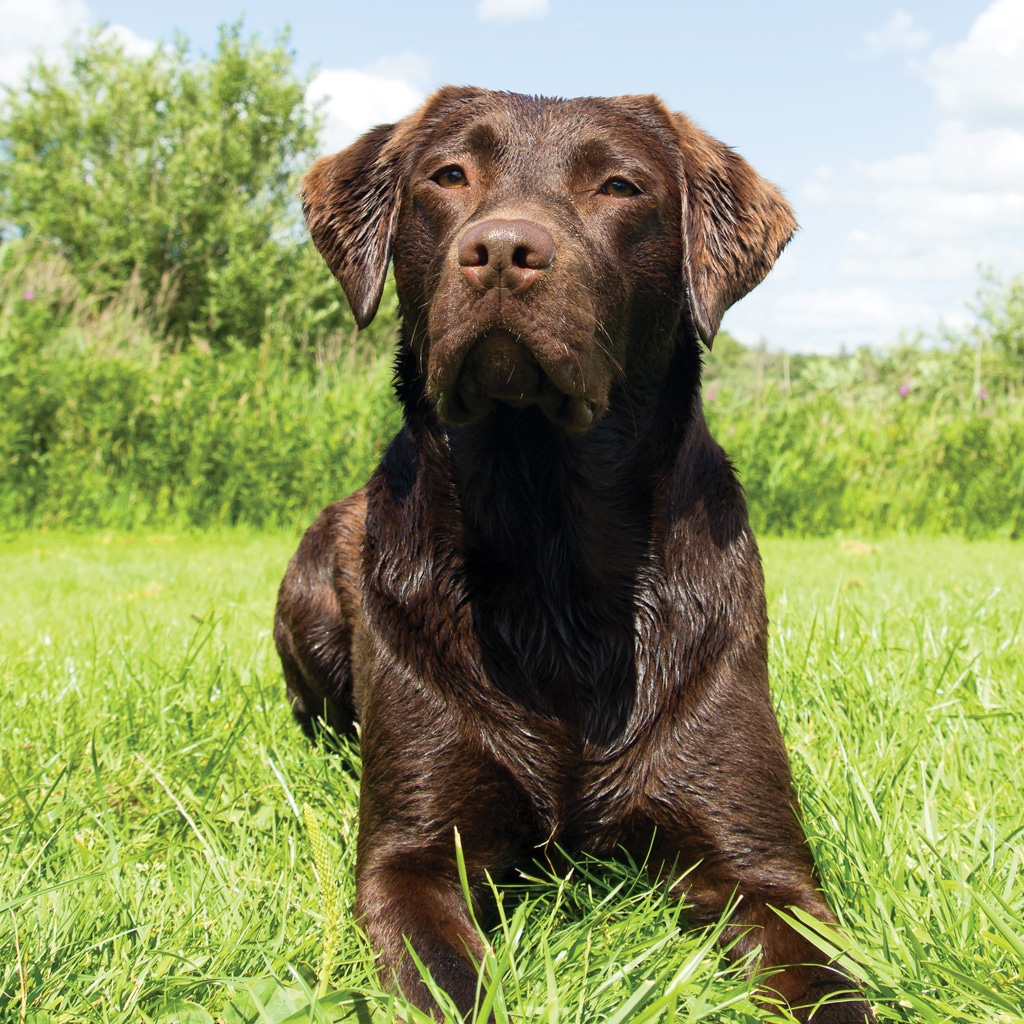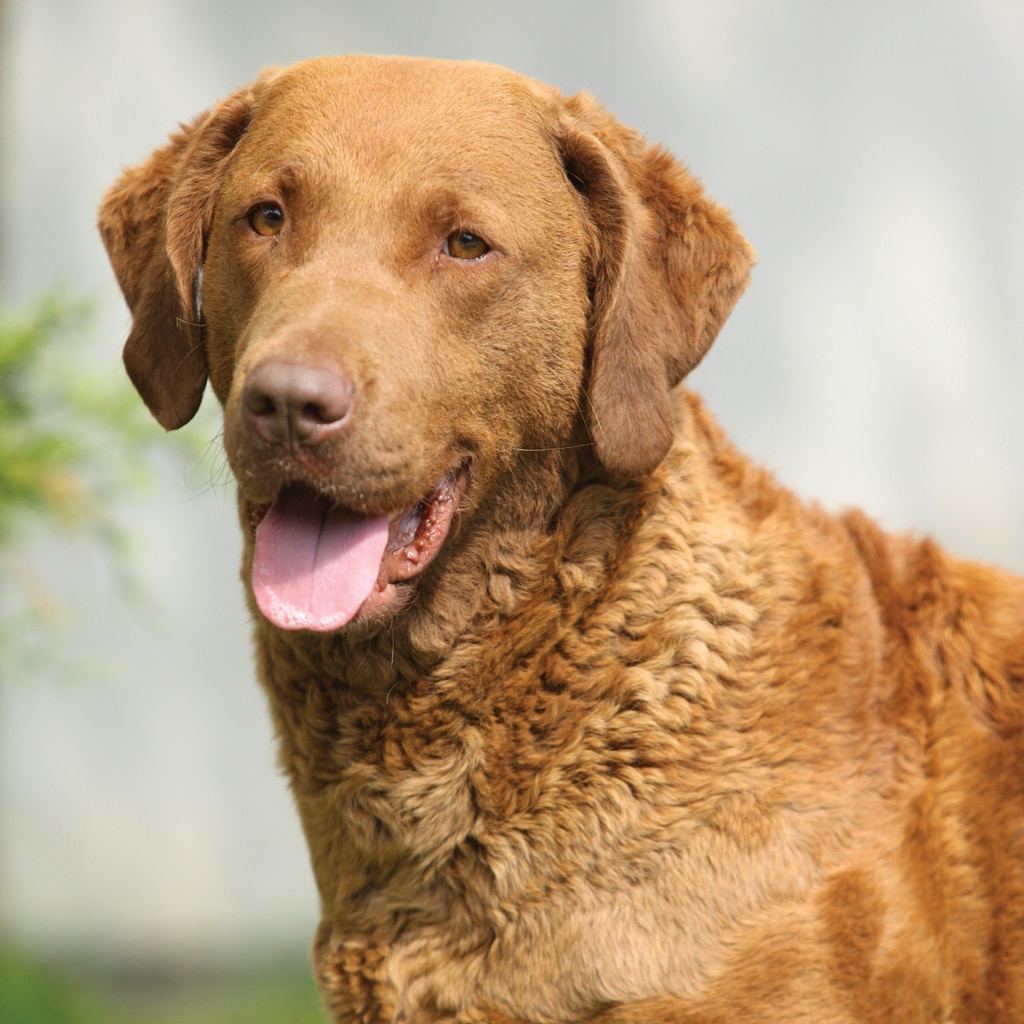

What’s the Difference Between the Labrador Retriever and the Chesapeake Bay Retriever?
Is the Labrador Retriever or the Chesapeake Bay Retriever right for you? Discover the differences between these similar-looking breeds!
Wondering about the differences between the Labrador Retriever and the Chesapeake Bat Retriever? These similar-looking breeds have some key differences. Read on to discover which is right for you!
The Labrador Retriever
Outgoing, spirited, affectionate family dog

Photo IJdema/Bigstock
Famously friendly, this sweet, lovable breed is ranked most popular in North America for good reason. This easygoing, amiable family dog bonds with the whole family and gets along well with other dogs. Their otter-like tail, wagging in enthusiasm, is likely to clear coffee tables.
And this breed is a beauty. The Lab’s hard coat comes in yellow, black, and chocolate, and is slightly oily to bestow water repellency—these dogs love the water.
Bred to be an all-around, rugged and versatile retriever, the Lab is an athlete and needs lots of exercise—don’t go out and get a Lab unless you are prepared to meet the needs of a high-energy breed developed to plow through densely tangled vegetation, churn through icy water, search around diligently to find what he’s looking for, and charge back and ask, “What’s next?”
This is the ultimate natural, all-purpose utility dog: strong, active, agile, and enthusiastic. And hungry—these dogs love their food. The breed’s popularity is well deserved: he’s amiable, versatile, and up for anything, including a cuddle on the couch with the family after a marathon fetch session.

Photo manushot/Bigstock
Is the Labrador Retriever right for you?
Find out more at: moderndogmagazine.com/labradorretriever
The Labrador Retriever vs. The Chesapeake Bay Retriever
The Chesapeake Bay Retriever
Athletic, intelligent, sensitive

Photo Zuzule/Bigstock
Famous for their wavy, waterproof coat and gorgeous amber eyes, the Chesapeake Bay Retriever is a tireless duck dog hailing from the Mid-Atlantic. Bred to retrieve waterfowl in an unforgiving, icy environment, this powerfully built breed (males can weigh up to 80 pounds) is strong yet sensitive. Bright, loyal, affectionate, and athletic, the Chessie is emotionally complex. “Chessies take to training, but they have a mind of their own and can tenaciously pursue their own path,” notes the AKC. And compared to many Retriever breeds, the Chessie is downright aloof, particularly where strangers are concerned.
The Chessie is assertive and confident, but with a soft side. These dogs bond intently with their loved ones, and are smart, biddable, and eager to please.
So, is the Chessie the right dog for you? If you love the idea of a Labrador Retriever, but can’t stop thinking about those amber eyes and that dense curly coat… then no, the Chessie is not for you.
The Chessie wants to work. For those in search of “just” a companion, this is not the breed. The Chessie’s not just a version of a Lab or a Golden. They’re their own dog—and they are a lot of dog. The Chessie loves their people but this breed needs to be busy—runs, hunts, walks, playtime. The Chessie is an “up for anything” dog—especially if it involves physical or mental exertion.

Photo eriklam/Bigstock
Is the The Chesapeake Bay Retriever right for you?
Find out more at: moderndogmagazine.com/chesapeakebayretriever
The Labrador Retriever vs the Chesapeake Bay Retriever: An At-a-Glance Comparison
The Labrador Retriever and the Chesapeake Bay Retriever are both popular sporting dog breeds, known for their intelligence, athleticism, and hunting abilities. However, there are some key differences between them in terms of appearance, temperament, history, and characteristics. Here’s a breakdown of the main differences:
1. Origin and History:
Labrador Retriever:
- Originated in Newfoundland, Canada, and was originally known as the St. John’s dog or Lesser Newfoundland.
- It was later refined in the UK into the Labrador Retriever.
- Traditionally used as a fishing and retrieving dog.
Chesapeake Bay Retriever:
- Originated in the Chesapeake Bay area of the United States in the 19th century.
- Developed specifically to work as a waterfowl hunting dog in the harsh conditions of the Chesapeake Bay.
- Known for its ability to retrieve in cold, rough waters.
2. Appearance:
Labrador Retriever:
- Coat: Short, dense, water-resistant double coat. The coat is soft and glossy.
- Color: Labs come in three standard colors: black, yellow (which can range from pale cream to fox-red), and chocolate.
- Build: Medium to large-sized dog with a well-balanced and athletic body.
- Tail: Known for the “otter tail,” thick at the base and tapering to the tip, which is well-suited for swimming.
Chesapeake Bay Retriever:
- Coat: Short, dense, and very water-resistant with a distinct oily texture. It also has a slight wave in the coat, especially around the shoulders and back.
- Color: Commonly found in brown or “liver” color, though they can also come in sedge (a reddish-tan) or deadgrass (light yellowish-brown).
- Build: Slightly more rugged and muscular than the Labrador, with a larger, broader head and thicker neck.
- Tail: Also has a thick tail, but it is often more tapered than that of the Labrador.
3. Temperament and Personality:
Labrador Retriever:
- Generally friendly, outgoing, and good-natured.
- Extremely social, making them excellent family pets and companions.
- Known for being easy-going and adaptable.
- They are highly trainable and eager to please, making them excellent working dogs.
Chesapeake Bay Retriever:
- More independent and sometimes more reserved than Labs, particularly around strangers.
- They tend to be more protective, with a strong guarding instinct, making them good watchdogs.
- They are highly driven, especially when it comes to waterfowl hunting, and are often more focused on their tasks than Labs.
- They can also be more territorial compared to Labs.
4. Energy Levels and Exercise Needs:
Labrador Retriever:
- Very high energy levels, requiring regular, vigorous exercise.
- Labs are known for their love of swimming and fetch, making them ideal companions for active families or individuals.
- They need plenty of mental stimulation to avoid boredom.
Chesapeake Bay Retriever:
- Also very active and athletic, but with a slightly higher need for physical activity than the Labrador.
- Due to their history as waterfowl retrievers, they thrive in water-based activities and long, challenging outdoor workouts.
- They require both mental and physical stimulation, but their more independent nature means they may enjoy more solitary activities than Labs.
5. Health and Lifespan:
Labrador Retriever:
- Lifespan: 10–12 years.
- Prone to hip dysplasia, elbow dysplasia, and obesity, particularly if not given enough exercise or a proper diet.
- Labs tend to have fewer breed-specific health issues compared to some other retrievers.
Chesapeake Bay Retriever:
- Lifespan: 10–13 years.
- Prone to hip dysplasia, elbow dysplasia, and some genetic disorders like progressive retinal atrophy (PRA).
- They also have a higher incidence of certain skin conditions due to their dense, oily coats.
6. Working Ability:
Labrador Retriever:
- Versatile working dog, excelling in many areas such as hunting, search-and-rescue, assistance dogs, and therapy work.
- They are also used extensively in detection work and as service dogs due to their intelligence and obedience.
Chesapeake Bay Retriever:
- Primarily bred for waterfowl hunting, and they excel in harsh conditions, particularly in cold water.
- Known for their determination and resilience in challenging environments, they are less versatile than the Lab in terms of working roles but are excellent at what they do.
7. Training:
Labrador Retriever:
- Very trainable due to their eagerness to please.
- They excel in obedience training and are often used in competitive dog sports or service work.
Chesapeake Bay Retriever:
- Highly intelligent but can be more independent, making training a bit more challenging.
- They respond well to firm, consistent training but may require a handler who can assert leadership.
Is the Labrador Retriever or the Chesapeake Bay Retriever Right For Me?
While both breeds are highly capable retrievers, the Labrador Retriever tends to be more social, versatile, and easier to train, making it a great family pet and working dog. The Chesapeake Bay Retriever is more independent, with a strong hunting drive and specialized abilities in harsh conditions, making it particularly suited for waterfowl hunters and those seeking a more protective, active, outdoor dog.
Join the newsletter and never miss out on dog content again!
"*" indicates required fields
By clicking the arrow, you agree to our web Terms of Use and Privacy & Cookie Policy. Easy unsubscribe links are provided in every email.





